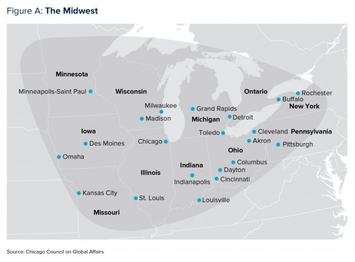
John Austin at the Michigan Economic Center is a long time commentator on Midwest economic issues, going back to at least his 2006 Brookings Institute report “The Vital Center.”
Austin is back with a new report, which could perhaps be seen as an update of sorts, called “A Vital Midwest: The Path to a New Prosperity,” released by the Chicago Council on Global Affairs.
In a region with a lot of naysayers, Austin has been a consistently optimistic voice about the future of the region. This report continues in that tradition. I think he always does a great job of identifying and highlighting the assets that are present in the region.
Some highlights:
A lot has changed since the Midwest served as the birthing ground of the great industries—processed food, retail commerce, aviation, cars, chemicals, steel, electronics, machinery, consumer durables, and many more—that powered 20th-century America.
Much has also changed since a generation ago, when globalization and new industrial rivals diminished the region’s economic primacy, shuttered hometown employers’ doors, and left many communities struggling. This collective transition earned the region its “Rust Belt” moniker.
Over recent years, the forces of technological disruption, new lifestyle and work preferences of young and mobile talent, changing demographics, and media in an increasingly wired world have continued to alter the dynamics of the global marketplace, the shape of communities, and the economic position and possibilities for the residents of the region.
Today the Midwest is neither an economic monolith nor, despite lingering popular misconceptions, a “Rust Belt.” Many Midwest communities, large and small, have successfully evolved from their industrial and farming roots and are winning in today’s globalized, tech-based, and knowledge-driven economy. Most of the region’s major metros—from the Twin Cities in the west to Indianapolis at the nation’s crossroads to Pittsburgh in the east—are diverse, thriving hothouses of knowledge work.
What’s more, all of the communities anchored by one of the region’s numerous top-flight research universities (such as Iowa City, Ann Arbor, and State College) are thriving in an economic era in which talent and innovation dominate.
Many other Midwest communities that are neither major metros nor home to top research universities have also found paths to new success by embracing the forces of economic change and building on their particular assets to create a new era of economic vitality.
These include cities such as Columbus, Indiana; Midland, Michigan; and Rochester, Minnesota—cities that are thriving as their anchor employers stay on the cutting edge of innovation in emerging sectors.
Click over to read the whole piece.
Aaron M. Renn is an opinion-leading urban analyst, consultant, speaker, and writer on a mission to help America’s cities and people thrive and find real success in the 21st century. He also regularly contributes to and is cited by national and global media outlets, and his work has appeared in the The Guardian (UK), The New York Times, and The Washington Post, along with many others. Renn was a Senior Fellow at the Manhattan Institute from 2015-2019 and is a Contributing Editor at its quarterly magazine City Journal.













Midwest Geography
I'm gonna quibble with the map in this article--and by extension, with the definition of the "Midwest." Of course definitions are arbitrary, but a map and article that puts Rochester and Pennsylvania in the Midwest is stretching the concept beyond meaning.
Defined by states, the Midwest includes Ohio, Indiana, Michigan, Wisconsin, Illinois, Iowa, Minnesota, Missouri, and perhaps Kentucky if you stretch it a bit. Not Pennsylvania.
A second possible definition is prime agricultural land in the Upper Mississippi Valley and its tributaries. "Upper" means north of the Ohio River. That would put Pittsburgh as a border city. (Though the joke about Pittsburgh is that it's the biggest city in W. Virginia.)
A third definition is the above, with the additional caveat that the region was settled originally under Quaker influence. That means high Catholic (and Amish) populations, such as found in Buffalo, Columbus, Milwaukee, Chicago and St. Louis. But certainly not Rochester, which is a redoubt of Yankee Protestantism. Perhaps also not Minneapolis, northern Michigan, or northern Wisconsin.
I'd count Buffalo as the Midwest's easternmost border city: the Lake Erie littoral is heavily agricultural; it's the most Catholic city in America (%-wise); especially before the Welland Canal, it was a transshipment point for Midwestern grain; it grew up as the gateway to the Midwest because of the Erie Canal.
By no reasonable definition is Rochester part of the Midwest.